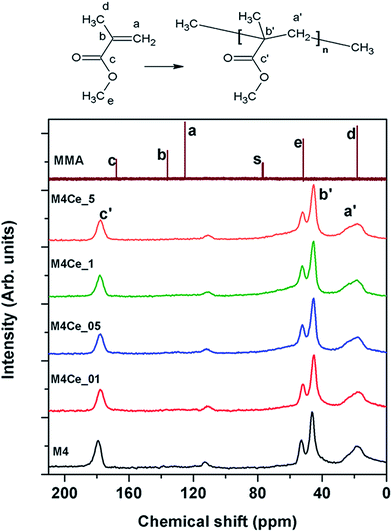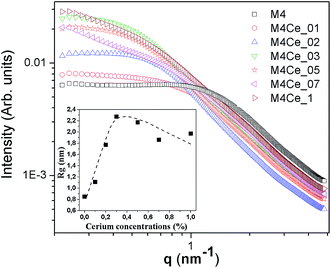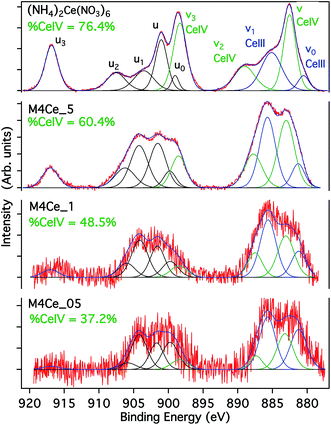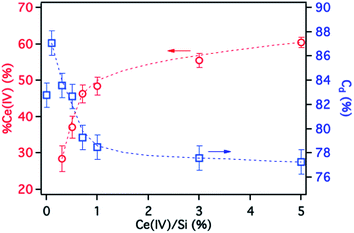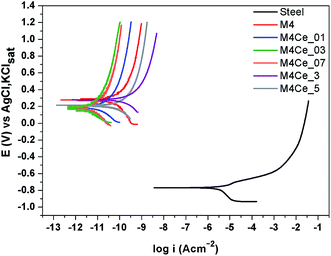Structural properties of cerium doped siloxane–PMMA hybrid coatings with high anticorrosive performance
S. V. Harb,
F. C. dos Santos,
B. L. Caetano,
S. H. Pulcinelli,
C. V. Santilli and
P. Hammer*
Instituto de Química, UNESP-Univ Estadual Paulista, 14800-900 Araraquara, SP, Brazil. E-mail: peter@iq.unesp.br; Fax: +55 16 3301 9692; Tel: +55 16 3301 9887
First published on 26th January 2015
Abstract
This study reports on the characterization of cerium doped organic–inorganic hybrid coatings by correlating their structural properties with the corrosion protection efficiency of coated carbon steel. The films were prepared via the sol–gel route from radical polymerization of methyl methacrylate (MMA) with 3-methacryloxy propyltrimethoxysilane (MPTS) followed by acidic hydrolysis and condensation of tetraethoxysilane (TEOS). After identifying the optimum proportion of polymeric and silica phase for the formation of a highly ramified structure (MMA/TEOS = 4), increasing concentration of Ce(IV) ions (0.1% < Ce/Si < 5%) was added to the inorganic precursor to enhance the passivating character of the films. Nuclear magnetic resonance, X-ray photoelectron spectroscopy, small angle X-ray scattering, atomic force microcopy and thermogravimetry were used to characterize the structural properties and electrochemical impedance spectroscopy, potentiodynamic polarization curves and field emission scanning electron microscopy were employed to evaluate the corrosion resistance of the coated samples in a standard saline environment. Structural analysis revealed a high degree of connectivity of the hybrid network, resulting in an enhanced thermal and electrochemical stability of the material. Detailed investigation of the structural effect of cerium species revealed that reduction of Ce(IV) ions during the polycondensation process catalyzes an increase of siloxane network connectivity (>87%) and enhances the polymerization of organic moieties. The electrochemical assays showed that the coatings possess an excellent long-term stability at high corrosion resistance of up to 10 GΩ cm2 and current densities about 6 orders of magnitude lower than that of the bare carbon steel. For elevated Ce(IV) doping levels the self-healing ability was observed preventing during long-term exposure further progression of the corrosion process.
1. Introduction
Organic–inorganic hybrids represent a new class of multifunctional materials, which combine the properties of the polymeric phase such as processability, flexibility, transparency and tunable hydrophobicity with high mechanical, thermal and chemical stability of ceramic materials, such as silica or alumina. The interaction between organic and inorganic phases on the molecular scale can be of physical or chemical nature, the latter providing covalent bonds between both components. Hybrid nanocomposites can be easily prepared by different routes in a large number of possible combinations between the inorganic and organic components, resulting in a wide range of properties of the resulting material. This versatility provides a great potential for a number of applications such as sensors, optoelectronic systems, catalysts, biomaterials, drug delivery systems and protective coatings.1–4Especially in the important field of corrosion protection of metallic surfaces, hybrid coatings can be considered as environmentally compliant alternatives for current chromate based passivation methods, which suffer the drawback of containing toxic hexavalent chromium species. One of the most promising candidates for efficient corrosion protection is the siloxane–polymethyl methacrylate system (siloxane–PMMA), showing high transparency, chemical and thermal stability and mechanical strength.1,3,5 Polymethyl methacrylate is a rigid, transparent, and colorless thermoplastic, well known as acrylic glass. The inclusion of an inorganic component such as silica into the PMMA matrix substantially improves its mechanical properties, thermal stability and adhesion to metallic substrates.3,6 Recent studies have shown that siloxane–PMMA coatings, deposited on steel, exhibit excellent corrosion resistance both in saline and in saline/acidic medium.3,7 Detailed analysis revealed that inorganic phase has an important role in promoting the adhesion between the film and metal substrate, while the organic phase hermetically seals the film structure. Thus the dense siloxane cross-link nodes interconnected covalently with short polymeric chains linked by the 3-methacryloxy propyltrimethoxysilane (MPTS) coupling agent, form a chemically inert barrier, which prevents the penetration of species that initiate corrosion process. In addition, these hybrid coatings exhibit hydrophobic character and as a consequence of their low intrinsic stress they can be prepared defect-free even with a thickness of several micrometers.3,7,8 Some other features favor their use among which can be highlighted the low costs of preparation, environmental compatibility, versatility, the mild conditions of the sol–gel synthesis and low temperatures used to cure the coatings. Consequently, siloxane–PMMA nanocomposite films prepared via sol–gel process posses a great potential for large-scale application as environmentally compliant protection of metallic surfaces.
Several recent studies have reported an increase of the passivating character of hybrid coatings by the addition of species, which act as corrosion inhibitors. In particular, cerium IV and III ions have been identified as very effective, satisfying some basic requirements expected of a corrosion inhibitor such as: ability to increase the polycondensation degree of the siloxane network, to form insoluble hydroxides and oxides of low toxicity, besides its easy handling and availability.9 The effects of low concentrations of cerium ions (<1000 ppm) in the structure of the hybrid has been investigated by some authors9–11 including our group,12 showing for polysiloxane hybrids the active role of Ce(IV) in the formation of silanol radicals by reduction of Ce(IV) in the presence of ethanol resulting in an increase of the connectivity of the hybrid network and thus providing coatings of superior anticorrosive performance. Another interesting aspect, which can explain the prolonged durability of these coatings is the fact that introduced Ce ions form by redox reactions (Ce(IV) ↔ Ce(III)) insoluble oxides and hydroxides preferentially in the corrosion affected regions, leading to the currently much discussed “self-healing” effect.13–15
Considering the great potential of cerium as corrosion inhibitor this work focuses on the structural investigation of Ce(IV) containing siloxane–PMMA hybrids used as corrosion resistant coatings on carbon steel. Based on the correlation of structural data with the corrosion protection efficiency first the most appropriate siloxane–PMMA matrix was identified,7 which was then used for addition of different amounts of Ce(IV). The structural properties of the siloxane–PMMA nanocomposites were studied as a function of Ce(IV) concentration using 29Si and 13C nuclear magnetic resonance (NMR), X-ray photoelectron spectroscopy (XPS), small angle X-ray scattering (SAXS), atomic force microscopy (AFM) and thermogravimetry (TGA), while the corrosion protection efficiency was investigated by electrochemical impedance spectroscopy (EIS), potentiodynamic polarization curves and field emission scanning electron microscopy (FE SEM) after immersion of the samples in neutral saline solution (NaCl 3.5%).
2. Experimental
The following commercially available reagents were used as received: tetraethylorthosilicate (TEOS), 3-methacryloxy propyltrimethoxy-silane (MPTS), methyl methacrylate (MMA), benzoyl peroxide (BPO), ethanol and tetrahydrofuran (THF), all acquired from Sigma-Aldrich. The MMA was previously distillated to remove the inhibitor of polymerization. Cerium(IV) in form of ammonium ceric nitrate [(NH4)2Ce(NO3)6, Sigma-Aldrich] was used as Ce(IV) dopant.The siloxane–polymethyl methacrylate hybrids were prepared using the sol–gel route in three stages: In the first step the MMA and the MPTS were copolymerized in THF using the thermal initiator (BPO) during 2 h at 70 °C under stirring in a reflux flask. Then, the inorganic component of the hybrid was prepared by hydrolysis and condensation of silicon alkoxide (TEOS). The hydrolysis of TEOS was carried in an ethanol solution by addition of acidified water (pH = 1) using nitric acid. Considered as the most suited precursor solution for the synthesis of corrosion protection coating, the sol with a MMA to TEOS molar ratio of 4 (reference sample M4) and all other ratios were kept constant: H2O/Si = 3.5, ethanol/H2O = 0.5, BPO/MMA = 0.01 and TEOS/MPTS = 23. In a third step Ce(IV) was added in form of ammonium ceric nitrate [(NH4)2Ce(NO3)6 into the inorganic precursor using five different Ce/Si molar percentage: 0.1, 0.2, 0.3, 0.5, 0.7, 1, 3 and 5%, denoted as M4Ce_01, M4Ce_02, M4Ce_03, M4Ce_05, M4Ce_07, M4Ce_1, M4Ce_3, M4Ce_5, respectively. After 1 h of stirring at 25 °C in a closed flask, the suspension was mixed with the copolymer solution forming a homogeneous and transparent sol used for the film deposition. The following thermal cure (150 °C) ensured a high degree of polycondensation of the Ce(IV) modified hybrid structure.
For electrochemical corrosion tests, AFM, FE SEM and XPS measurements, coated A1010 carbon steel substrates (25 mm × 25 mm × 4 mm) were used, having a nominal composition (wt%) of C = 0.15%, Mn = 0.55 to 0.69%, Si = 0.13%, P = 0.03% and S = 0.01%, with the balance of Fe. The deposition of hybrid coatings was performed by dip-coating at a withdraw rate of 14 cm min−1. Then the coated substrates were heated at 60 °C for 24 h and finally cured at 160 °C during 3 h. The coating thickness was determined by profilometry (Talystep, Taylor & Hobson). The adhesion of the films to the steel surface was evaluated by the ASTM D4541 method using a Posi-Test Pull-Off Adhesion Tester (De Felsko), determining the tensile pull-off force of detaching.
Unsupported hybrid films for NMR, SAXS and TGA analysis were obtained by drying and curing treatment of the sol in a Teflon dish. For NMR measurements the films were milled to obtain a powder. Solid-state 29Si and 13C magic-angle spinning nuclear magnetic resonance (MAS-NMR) spectra were recorded for powder samples using a VARIAN spectrometer operating at 300 MHz and 7.05 T. The Larmor frequency for 29Si was 59.59 Hz. The spectra were obtained from the Fourier transform of the free induction decays (FID), following a single π/2 excitation pulse and a dead time of 2 s. Chemical shifts were referenced to tetramethylsilane (TMS), used as external standard. Proton decoupling was always used during acquisition of the spectra. Due to the high sensitivity of the NMR measurements, the uncertainty in the chemical shift values was less than 0.2 ppm.
The TG curves were recorded using a SDT Q600 (TA Instruments) thermal analysis system, with nitrogen as purge gas at a flow rate of 70 mL min−1. About 7 mg of hybrid film was placed into alumina crucibles, and heated at a rate of 10 °C min−1 up to 600 °C.
The XPS analysis was carried out at a pressure of less than 10−7 Pa using a UNI-SPECS UHV instrument. The Mg Kα line was used (hν = 1253.6 eV) and the analyzer pass energy for the high-resolution spectra was set to 10 eV. The inelastic background of the Ce 3d and O 1s spectra was subtracted using Shirley's method. Due to sample charging, the binding energy scale was corrected using the C 1s hydrocarbon component of the PMMA set to 285.0 eV. The composition was determined with an accuracy of ±10% from the ratio of the relative peak areas corrected sensitivity factors of the corresponding elements. The spectra were fitted without placing constraints using multiple Voigt profiles. The width at half maximum (FWHM) varied between 1.0 and 2.0 eV and the accuracy of the peak positions was ±0.1 eV.
The SAXS measurements were performed using the SAS 2 beam-line at the National Synchrotron Light Laboratory (LNLS) in Campinas, Brazil. An asymmetrically cut and bent Si(111) crystal was used to focus horizontally the monochromatic X-ray beam (λ = 0.1608 nm). The scattering intensity I(q), collected with a two-dimensional X-ray detector (Pilatus, 300k, 84 mm × 107 mm), was determined as a function of the modulus of the scattering wave vector q = (4π/λ)![[thin space (1/6-em)]](https://www.rsc.org/images/entities/char_2009.gif) sin
sin![[thin space (1/6-em)]](https://www.rsc.org/images/entities/char_2009.gif) θ, θ being half of the scattering angle.
θ, θ being half of the scattering angle.
Atomic force microscopy (AFM) measurements were carried out using the tapping mode of the Aglient 5500 instrument and field emission scanning electron microscopy (FE SEM) was performed using the FEI Inspect F50, installed at the Electron Microscopy Laboratory (LME) of the National Nanotechnology Laboratory (LNNano) in Campinas, Brazil.
The electrochemical measurements of coated and uncoated steel samples were carried out for different immersion periods at 25 °C in 80 mL of a naturally aerated 3.5% NaCl solution at room temperature. For electrochemical measurements an Ag/AgCl/KClsat electrode, connected to the working solution through a Luggin capillary, was used as reference, and a Pt grid as the auxiliary electrode. The working electrode was mounted in an electrochemical flat cell, exposing a geometric area of 1 cm2 to the solution. Polarization curves were recorded after 4 h of immersion into the electrolyte using a potentiostat/galvanostat (EG&G Parc-273), in the overpotential range of −150 mV to +1000 mV versus the open circuit potential, EOC, referred to the Ag/AgCl/KClsat electrode, at a scan rate of 0.166 mV s−1. The corrosion potentials and apparent corrosion current density values were directly estimated from classical E (mV) vs. log![[thin space (1/6-em)]](https://www.rsc.org/images/entities/char_2009.gif) i (A cm−2) curve. The polarization curves were qualitatively analyzed and only used to compare the coated materials with different formulation. The electrochemical impedance spectroscopy (EIS) measurements were performed after 1 day and for some chosen samples during 300 days of immersion in saline solutions using a Potentiostat/Galvanostat EG&G Parc-273 and a Frequency Response Analyzer Solartron-SI1255. The EIS tests were performed applying 10 mV (rms) to the EOC value, starting from 105 to 5 × 10−3 Hz with 10 points per decade. For all samples, EOC was measured for 1 h, then the EOC value was applied for 15 min with simultaneous measuring of the current, which stabilized during this time, and finally the impedance spectra recorded. To guarantee the reproducibility of the results all electrochemical measurements were performed in duplicate.
i (A cm−2) curve. The polarization curves were qualitatively analyzed and only used to compare the coated materials with different formulation. The electrochemical impedance spectroscopy (EIS) measurements were performed after 1 day and for some chosen samples during 300 days of immersion in saline solutions using a Potentiostat/Galvanostat EG&G Parc-273 and a Frequency Response Analyzer Solartron-SI1255. The EIS tests were performed applying 10 mV (rms) to the EOC value, starting from 105 to 5 × 10−3 Hz with 10 points per decade. For all samples, EOC was measured for 1 h, then the EOC value was applied for 15 min with simultaneous measuring of the current, which stabilized during this time, and finally the impedance spectra recorded. To guarantee the reproducibility of the results all electrochemical measurements were performed in duplicate.
3. Results and discussion
3.1 Structural analysis
Fig. 1 displays a representative image of a siloxane–PMMA hybrid coated carbon steel (Fig. 1a) and the AFM surface morphology of sample M4Ce_07 containing 0.7% Ce (Fig. 1b). All films show a very smooth surface (RRMS = 0.3 nm) without features, indicating the formation of a dense and compact layer. The thickness of the transparent coatings increased from about 1 μm to 1.8 μm with the cerium content, due to the slight viscosity increase of the precursor solution.10 The tensile pull-off force of detaching was for all coatings higher than the 8 MPa, the limit of the PULL-OFF Adhesion Tester, indicating a very good adhesion of the film to the substrate. This might be related with the strong interaction of the hydroxyl-rich oxide layer promoting a strong interaction between the steel substrate and the silanol groups of the inorganic part of the hybrid.16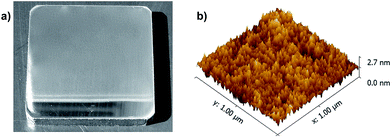 | ||
| Fig. 1 (a) Representative image of M4Ce_07 siloxane–PMMA hybrid coated carbon steel (A1010), and (b) AFM topography of the sample. | ||
The polymerization of the methacryloxy groups was studied by 13C solid state MAS-NMR, shown in Fig. 2. The comparison of the hybrid spectra with resonance signals of MMA evidenced the formation of a cross-linked organic phase, showing signals of quaternary carbon atoms (b′), C![[double bond, length as m-dash]](https://www.rsc.org/images/entities/char_e001.gif) O groups bonded to aliphatic carbon groups (c′), and aliphatic –CH2– groups (a′).3 The absence of MMA signals at 125 ppm (a) and 137 ppm (b) for all samples, related to vinylic carbon atoms (C
O groups bonded to aliphatic carbon groups (c′), and aliphatic –CH2– groups (a′).3 The absence of MMA signals at 125 ppm (a) and 137 ppm (b) for all samples, related to vinylic carbon atoms (C![[double bond, length as m-dash]](https://www.rsc.org/images/entities/char_e001.gif) C), and C
C), and C![[double bond, length as m-dash]](https://www.rsc.org/images/entities/char_e001.gif) O groups bonded to these C atoms (c), evidenced the complete polymerization of acrylate monomer. Additionally, the small features, located at 12 ppm and 28 ppm, were identified as due to C–Si and C–C–C groups of MPTS, respectively.3
O groups bonded to these C atoms (c), evidenced the complete polymerization of acrylate monomer. Additionally, the small features, located at 12 ppm and 28 ppm, were identified as due to C–Si and C–C–C groups of MPTS, respectively.3
The local bonding structure of the inorganic phase was studied by 29Si nuclear resonance spectroscopy. Fig. 3 shows the spectra of four chosen hybrid samples prepared with increasing Ce(IV)/Si molar percentage of 0% (M4), 0.1% (M4Ce_01), 1% (M4Ce_1) and 5% (M4Ce_5). The main spectral features are the broad resonance peaks at about −92,−102 and −110 ppm, assigned to Q2 (Si(OSi)2(OR)2), Q3 (Si(OSi)3(OR)) and Q4 (Si(OSi)4, R = H or CH2CH3) species, which are related to the polycondensation product of TEOS. Resonances related to MPTS polycondensation products, containing one non-hydrolysable Si–C bond, were observed at −44, −56 and −65 ppm, assigned to T1 (–CH2Si(OSi)(OR)2, R = H or CH3), T2 (–CH2Si(OSi)2(OR)) and T3 (–CH2Si(OSi)3) units.3,17 The absence of monomer species T0 (–CH2Si(OR)3) and Q0 (Si(OR)4) is in agreement with the cluster–cluster condensation mechanism, expected under strongly acid conditions.18 The proportions of TJ and QJ species present in the hybrid–nanocomposite were extracted from the spectra by a peak fitting procedure used to determine the relative peak area of each species. As expected, the intensity ratio of QJ/TJ species was found to be close 2, in agreement with the proportions of the TEOS and MPTS precursors used in the synthesis. The polycondensation degree, Cd, of the inorganic phase was determined from the proportions of each TJ and QJ species according to the equation: Cd = [(T1 + 2T2 + 3T3)/3 + (Q1 + 2Q2 + 3Q3 + 4Q4)/4] × 100.
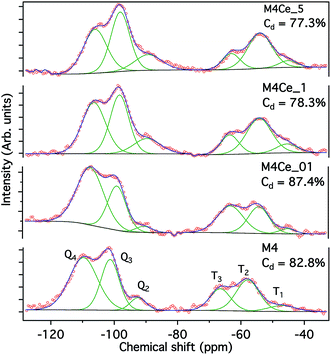 | ||
| Fig. 3 29Si NMR spectra of hybrids prepared at a ratio MMA/MPTS = 4 and Ce/Si molar percentages of 0% (M4), 0.1% (M4Ce_01), 1% (M4Ce_1) and 5% (M4Ce_5). | ||
The Cd values extracted from the spectra by fitted Voigt profiles are listed in Table 1. The results show a steep increase of connectivity of the inorganic phase from ∼83% (M4 reference) to about 87% for the M4Ce_01 sample. With increasing cerium concentration the Cd values decrease below 80% (Table 1). The increase of the degree of polycondensation for low cerium doping levels can be related with the active role of Ce(IV) as very efficient oxidation agent, which enhances the polycondensation process by creation of silanol radicals, thus leading a higher network connectivity, as reported for polysiloxane hybrids.9,12 However, as shown below, the lower polycondensation degree observed for cerium rich samples might come form an another effect, related with the increasing formation of cerium oxide and hydroxide species. To elucidate this aspect the samples were analyzed using X-ray small angle X-ray scattering and by X-ray photoelectron spectroscopy.
| M4 ref. | Ce(IV) doped hybrids | |||||||
|---|---|---|---|---|---|---|---|---|
| M4Ce_01 | M4Ce_03 | M4Ce_05 | M4Ce_07 | M4Ce_1 | M4Ce_3 | M4Ce_5 | ||
| a Error: ±1.0.b Error: ±5%.c Below the XPS detection limit.d Stabilization by self-healing. | ||||||||
| NMR | ||||||||
| Cda (%) | 82.8 | 87.1 | 83.6 | 82.7 | 79.3 | 78.5 | 77.6 | 77.3 |
| XPS Ce conc.b (at.%) | — | —c | <0.1 | 0.1 | 0.15 | 0.2 | 0.4 | 1.1 |
| XPS Ce(IV) fraction (%) | — | —c | 28.5 ± 4 | 37.2 ± 3 | 46.4 ± 2.5 | 48.5 ± 2.5 | 55.5 ± 2 | 60.4 ± 1.5 |
| DTG events | ||||||||
| d1 intensity | Ref. | Weak | Weak | Weak | Weak | Weak | Weak | Weak |
| d2 intensity | Ref. | Weak | Equal M4 | Equal M4 | Strong | Strong | Strong | Strong |
| d3 (°C) | 390 | 395 | 395 | 398 | 405 | 408 | 410 | 415 |
| EIS max. stability (days) | 42 | 85 | 96 | — | 304 | 65 | 48d | 304d |
Fig. 4 displays the SAXS intensity profiles corresponding to siloxane–PMMA samples with Ce/Si molar ratio between 0% and 1%. The scattering curves show a Gaussian decay for intermediate q-values and a plateau in the lower q-region, indicative for the Guinier regime.19 This feature is generally observed for a biphasic system satisfying a two-electron density model in which a dilute set of non-interacting particles is dispersed in a homogenous matrix. Considering for all samples a volume fraction of inorganic phase of less than 20% the scattering can be attributed to the siloxane nanoparticles embedded in the PMMA matrix.20 The shift of the plateau to lower q-values with Ce/Si molar ratio up to 0.3% indicates that the siloxane nanoparticles increase in size. For higher cerium concentrations the saturation behavior suggests that additional cerium does not significantly influence the polycondensation process of the inorganic phase, in agreement with the lower Cd values observed by NMR.
To determine the average size of the siloxane scattering centers the Guinier equation was applied:19 I(q) = I(0)exp(−(Rgq)2/3) for q → 0, where Rg is the Guinier average of the radius of gyration of the scattering particles and I(0), the pre-exponential term. For two-electron density systems the pre-exponential is given by I(0) = N(Δρ)2〈ν2〉, N being the specific number of particles, Δρ the difference in electron density between both phases and 〈ν2〉 the average of the squared particle volume. A nearly linear dependency between ln(I(0)) and Rg2 was observed as the Ce/Si molar ratio increases up to 0.3, indicating the invariance of N and (Δρ). Thus the observed Rg increase from about 0.8 nm (M4 reference) to about 2.3 nm (M4Ce_03) (inset of Fig. 4) could proceed through the cerium induced monomer accretion to individual siloxane cluster, rather than by cluster–cluster aggregation growth. Again, up to intermediate doping levels the observed dependence suggests a active role of Ce(IV) in the enhanced growth of a cross-linked siloxane phase, a result consistent with NMR data.
The quantitative XPS analysis confirmed the formation of polysiloxane hybrid films with a fixed fraction of the organic and inorganic phase, in good agreement with the nominal MMA/TEOS ratio of 4 (C: 55.0 at.%, O: 38.5 at.%, Si: 6.5 at.%). According to Table 1, the cerium concentration increased with the introduced quantity of Ce(IV) from a value below the detection limit (∼0.05 at.%) to 1.1 at.%. It is important to note, that XPS spectra obtained for unsupported hybrid films, used for the NMR, XAS, SAXS and thermal analyses, were identical with those obtained for films prepared by dip-coating.
The influence of Ce(IV) addition on the chemical bonding structure of the hybrid phase was investigated by the peak-form analysis of the Ce 3d spectra to determine the degree of Ce(IV) reduction, which is expected to be indicative for Ce(IV) oxidation power in the formation of silanol and methacrylate radicals during the polymerization process.9,12 Fig. 5 shows the Ce 3d spectra fitted using 5 spin–orbit doublets for the M4Ce_05, M4Ce_1 and M4Ce_5 samples and the Ce(IV) ammonium ceric nitrate salt reference. Being close to the detection limit, the deconvolution of noisy Ce 3d spectra of the sample with the lowest doping level (M4Ce_01) was not possible. The fitted components labeled vi and ui are due to corresponding 3d5/2 and 3d3/2 spin–orbit states. According to Reddy et al.21 parts of the complex but distinct Ce 3d features are related to the final-state occupation of the Ce 4f level, resulting in shake-down satellites. The v3/u3 and v1/u1 doublets, separated by 18.6 eV, are due to primary photoemission from Ce(IV) and Ce(III) cations, respectively. The v/u and v2/u2 doublets are shake-down features resulting from the transfer of one or two electrons from a filled O 2p to an empty Ce 4f orbital during the Ce(IV) photoemission, and the v0/u0 doublets are related to the shake-down of Ce(III) cations.
It is well known that cerium species suffer an X-ray induced photo-redox process resulting in a partial conversion of Ce(IV) into Ce(III) and vice versa.12 Therefore, to be able to follow the influence of the Ce(IV) oxidation agent on the phase formation process, identical irradiation dose and acquisition time was used for all photoemission experiments. The fitted spectrum of the ammonium ceric nitrate reference has shown that the X-ray induced reduction led to a Ce(IV) fraction of 76,4% (Fig. 5). Relative to this value the percentages of remaining Ce(IV), derived from relative Ce(IV) and Ce(III) sub-peak intensities, were lowest for hybrids with low cerium concentrations. For all hybrids, except M4Ce_01, the Ce(IV) percentages are listed in Table 1 and plotted in Fig. 6 together with the NMR polycondensation degree (Cd) as a function of the Ce to Si molar percentage. The data show that relative to the ceric nitrate reference up to 62% of Ce(IV) was reduced to Ce(III) during the polycondensation and polymerization process of hybrids with low cerium content. Combining these results with NMR data it can be concluded that for low doping levels the presence of Ce(IV) leads to an increase of the formation rate of silanol and methacrylate radicals which enhance the polycondensation reactions and the polymerization of organic moieties, thus leading to the formation of highly cross-linked hybrid network. At elevated doping levels the influence of Ce(IV) on the kinetics of the phase formation is still present, however, the excess of the dopant leads to formation of cerium phases, such as oxides and hydroxides, which might have influence on the thermal and electrochemical characteristics of the material. Additionally, XPS results for cerium rich M4Ce_5 sample have shown traces of nitrogen in the form of nitrate (NO3−), located at N 1s binding energy of 407.5 eV, suggesting the presence of a small quantity of re-precipitated Ce salt.
Information on the thermal stability, related to the overall connectivity of the hybrid network, were obtained by thermogravimetric analysis. The differential curves (DTG), obtained in nitrogen atmosphere (Fig. 7), indicate the existence of four degradation stages of the siloxane–PMMA hybrid. The first three events (d1, d2 and d3) are associated with the depolymerization of PMMA. The events at about 240 °C (d1) and 310 °C (d2) are associated with the rupture of the head-to-head segments and to unsaturated chain ends, while the event at 400 °C, corresponds to random scissions of the polymer chains.22,23 The small event at about 480 °C (d4), can be attributed to the dehydration of silanol groups corresponding to T1, T2, Q2 and Q3 species present in the SiO2 network.18 Except for the M4Ce_5 sample the thermal stability of the hybrids is limited to about 200 °C. It is interesting to note, that relative to the M4 reference, the hybrids with lower cerium concentration exhibit a suppressed degradation rate for d1 and d2 events, most clearly visible for the M4Ce_01 sample. On the other hand, with increasing Ce content, a systematic shift of the d3 event from 390 °C (M4) to temperatures up to 415 °C (M4Ce_5) occurs, indicating a higher thermal stability of the cerium rich phase against random depolymerization of the organic segments. Both effects evidence an overall cerium induced increase of the thermal stability. This effect is more evident for intermediate Ce/Si molar ratios, corresponding to an overall cerium doping level of about 500 ppm. Table 1 summarizes the relative intensities of d1 and d2 event relative to the M4 reference, together with the temperature of the T3 event. Although the polycondensation degree of the M4Ce_07 sample is somewhat lower than that of the M4 reference, decisive for the barrier propriety is the overall connectivity of the hybrid network, discussed below. As can be observed in Table 1 the thermal stability against depolymerization of the M4Ce_07 sample is about 15 °C higher than for the M4 reference, indicating that hybrids in the intermediate cerium concentration range combine elevated inorganic network connectivity with a highly cross-linked structure. The DTG data are consistent with AFM, NMR and XPS results, indicating the formation of a compact and highly cross-linked structure with enhanced thermal stability.
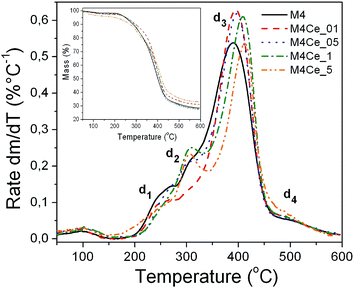 | ||
| Fig. 7 DTG and TG (insert) curves obtained for hybrids prepared at a ratio MMA/MPTS = 4 and Ce/Si molar percentages of 0% (M4), 0.1% (M4Ce_01), 0.5% (M4Ce_05), 1% (M4Ce_1) and 5% (M4Ce_5). | ||
3.2 Corrosion analysis
The electrochemical performance of hybrid coatings, containing increasing concentration of cerium, was evaluated using electrochemical impedance spectroscopy curves, recorded for different periods of immersion in saline solution (3.5% NaCl). Fig. 8 displays the complex plane Nyquist and Bode plots for the M4 reference sample and cerium hybrid coatings after 1 day of immersion. Compared to bare steel, the coated samples show up to 6 orders of magnitude higher impedance modulus (Fig. 8b), reaching almost 10 GΩ cm2 for the sample with intermediate cerium concentration (M4Ce_07). This values is about two orders of magnitude higher than the highest corrosion resistance reported for cerium doped polysiloxane hybrids11,12,24 and higher than those recently reported for epoxy-silane coatings on Mg alloy, however using a 0.3% NaCl solution.25 It should be noted, that this EIS performance, obtained for only 1–2 μm thick hybrid films, already approaches the behavior of high performance paints. Furthermore, it can be observed that at low frequencies the hybrid coatings containing intermediate cerium concentrations show a slightly better performance than the M4 reference, while the cerium rich samples display the highest Z modulus in the higher frequency range (1–105 Hz). The latter feature might be related to a passivation effect due to cerium oxide/hydroxide formation, a point that will be discussed below. For all samples the phase angle dependence (Fig. 5c) shows a broad band with nearly pure capacitive behavior (Φ < −80°), which extends over almost five orders of magnitude (M4Ce_07), suggesting the presence of at least two time constants, one in the high frequency range of 1–10 kHz (HF), and the second in the low frequency interval (LF) of 1–10 Hz. | ||
| Fig. 8 Complex plane impedance (a), modulus impedance (b) and phase (c) plots of bare carbon steel and hybrid coatings prepared at a ratio MMA/MPTS = 4 and Ce/Si molar percentages between 0% (M4) and 5% (M4Ce_5), after 1 day exposure to unstirred and naturally aerated 3.5% NaCl solution. (The solid lines are fits according the equivalent circuit, shown in the insert of Table 2, for M4_Ce05 and M4_Ce07 coated samples.) | ||
The electrical equivalent circuit used to fit the experimental data of M4Ce_05 and M4Ce_07 (inset of Table 2 and fits in Fig. 8), representative for all other samples, contains two time constants: R2 and CPE2 refer to the HF resistance and constant phase element for charge transfer in the surface region of the coating in contact with the solution, expected to act in the uptake process, while R1 and CPE1 are related to the LF resistive and capacitive response of the coating including the film/substrate interface.12 In the case of the M4Ce_07 sample, the low frequency time constant is more evident, extending the broad phase angle band to lower frequencies. The derived model parameters are summarized in Table 2, showing for M4Ce_07 sample a slightly better performance than that found for the M4Ce_05 coating.
| Sample | M4Ce_05 (1 day) | M4Ce_07 (1 day) | M4Ce_07 (304 days) | |||
|---|---|---|---|---|---|---|
| a Error (%). | ||||||
| χ2 | 0.84 × 10−3 | 0.69 × 10−3 | 1.3 × 10−4 | |||
| R1 (Ω cm2) | 2.87 × 107 | (7.00)a | 5.77 × 107 | (8.69) | 6.13 × 106 | (8.8) |
| CPE1 (F cm−2 sn−1) | 4.59 × 10−9 | (0.94) | 3.88 × 10−10 | (3.88) | 2.30 × 10−9 | (0.83) |
| n1 | 0.59 | (1.46) | 0.97 | (0.66) | 0.95 | (0.09) |
| R2 (Ω cm2) | 8.33 × 108 | (3.64) | 5.49 × 109 | (0.70) | 3.42 × 108 | (1.29) |
| CPE2 (F cm−2 sn−1) | 3.14 × 10−9 | (0.90) | 1.71 × 10−9 | (0.88) | 1.71 × 10−9 | (1.63) |
| n2 | 0.96 | (0.11) | 0.87 | (0.11) | 0.66 | (0.62) |
Despite the excellent EIS performance of the coatings observed after one day exposure, a more important aspect is whether the high corrosion resistance can be maintained during long time periods, thus providing an applicable system for efficient corrosion protection of metallic surfaces. The immersion time dependence of the sample M4Ce_07, presented in Fig. 9, evidences the high protection efficiency of the coating maintaining the impedance modulus above 108 Ω cm2 for more than 10 months contact with the saline environment (Fig. 9b). With increasing exposure time the LF time constant is shifted towards higher frequencies close to that observed for bare steel (∼10 Hz). Although after 10 months of exposure the impedance value is still four orders of magnitude higher than that of bare steel, this shift indicates the beginning of a corrosion progress at the film/steel interface.
 | ||
| Fig. 9 Complex plane impedance (a), modulus impedance (b) and phase (c) plots of the M4Ce_07 hybrid coating prepared at a ratio MMA/MPTS = 4 and Ce/Si molar percentage of 0.7%, after exposure of up to 304 days in unstirred and naturally aerated 3.5% NaCl solution. (The solid line fits the data for 1 day exposure, according the equivalent circuit, shown in the inset of Table 2.) | ||
To analyze the aging process of the samples in more detail, the time dependence of the elements in the equivalent circuit was determined and plotted in Fig. 10. For the studied sample (M4Ce_07), a small but continuous decrease of the resistance values and a increase of the constant phase element can be observed. While the double layer capacitance CPE2 increases by a factor of 5, the coating capacitance CPE1 only by a factor 1.4. Compared with a conventional capacitor having a CPE exponent of n = 1, an exponent of n = 0.5 is associated with a diffusion process through film pores.26 Values in the intermediate range 0.5 < n < 1 are related to coating roughness and inhomogeneous current distribution. As the CPE exponent for the high frequency time constant (R2/CPE2) decreases from 0.87 to 0.66, while for the low frequency time constant (R1/CPE1) only from 0.97 to 0.95 (Table 2), it can be concluded that the reduced corrosion resistance of the M4_07 coating after long-term exposure is primarily caused by a continuous increase of the porosity of the near surface region of the coating.
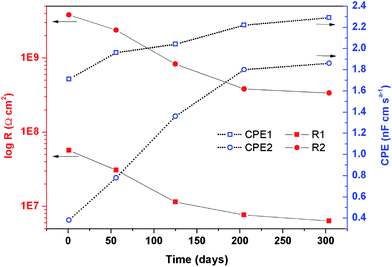 | ||
| Fig. 10 Time dependence of resistances R1, R2 and constant phase elements CPE1, CPE2 of the equivalent circuit (inset Table 2) determined for the M4Ce_07 hybrid in 3.5% NaCl solution. | ||
The increase of surface roughness of the coating and the beginning corrosion process at the film/steel interface was evidenced by the inspection of the surface by FE SEM, which showed after 328 days contact with the electrolyte the formation of several micro-pits, with a size of about 250 nm (Fig. 11). The maximum period of stability, defined as time interval before suffering an impedance drop of about 2–4 orders of magnitude, are listed in Table 1 for all samples. The values indicate a tendency of elevated anticorrosive stability for coatings in the intermediate cerium concentration range. It should be pointed out that to best of authors' knowledge this long-term performance at elevated impedance values was not yet reported for protective coatings with micrometric thickness.
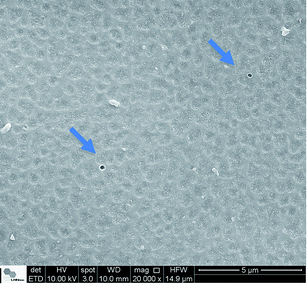 | ||
| Fig. 11 FE SEM image of the M4Ce_5 coating after 328 days exposure in unstirred and naturally aerated 3.5% NaCl solution, showing localized pits of about 250 nm (arrows). | ||
Although samples with higher cerium concentrations were less stable in chloride solution than those in the intermediate concentration range, another interesting time-dependence was observed, which can be directly related to the self-healing effect of cerium.13–15 In contrast to samples with low cerium content, M4Ce_3 and M4Ce_5 showed after a local failure of the coating only an impedance drop of about two orders of magnitude and than remained stable at about 107 Ω cm2. This time dependence, shown in Fig. 12 for the coating M4Ce_5, is related to the presence of insoluble cerium oxides and hydroxides,12,14,27 preferentially formed in pits by the reaction of Ce3+ and Ce4+ with residual hydroxyl groups of the hybrid, according to eqn (1)–(4). Evidence for the presence of oxides and hydroxides in cerium-rich films comes from the analysis of the XPS O1s spectra. For sample M4Ce_5 the spectral components of Fig. 13 show a clear presence of cerium oxide (Ce–OH) and cerium dioxide (Ce–O) phases in the low binding energy tail of the spectum.28 The three principals spectral components are related to bonding environments of oxygen present in the acrylic (O–C![[double bond, length as m-dash]](https://www.rsc.org/images/entities/char_e001.gif) O and O
O and O![[double bond, length as m-dash]](https://www.rsc.org/images/entities/char_e001.gif) C) and siloxane (O–Si) part of the hybrid.28
C) and siloxane (O–Si) part of the hybrid.28
| Ce3+ + 3OH− ⇆ Ce(OH)3 | (1) |
| 2Ce(OH)3 ⇆ Ce2OH3 + 3H2O | (2) |
| Ce3+ + 4OH− ⇆ Ce(OH)4 | (3) |
| Ce(OH)4 ⇆ CeO2 + 2H2O | (4) |
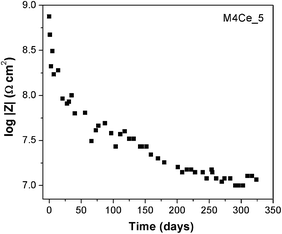 | ||
| Fig. 12 Time dependence of the impedance modulus (M4Ce_5), showing a stabilization at about 107 Ω cm2, indicative for the cerium induced self-healing effect of the coating. | ||
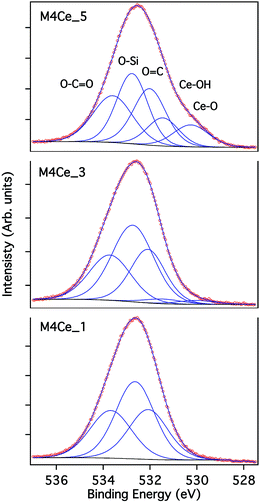 | ||
| Fig. 13 Deconvoluted XPS O 1s spectra of Ce(IV) doped hybrids prepared at a ratio MMA/MPTS = 4 and Ce/Si molar percentages of 1% (M4Ce_1), 3% (M4Ce_3) and 5% (M4Ce_5). | ||
The excellent corrosion protection efficiency in saline medium of Ce(IV) doped hybrid coatings was confirmed by the comparison of the potentiodynamic polarization curves with the M4 reference, displayed in Fig. 14. All coatings show very low current densities and overpotential stability up to 1 V, corresponding to electrical field of about 106 V m−1. While the current density of the M4 reference in saline medium is about 5 orders of magnitude lower than that of bare steel, samples with intermediate Ce content exhibit even lower current densities approaching 10−11 A cm−2. To compare the polarization results with those obtained by impedance spectroscopy, the polarization resistances (Rp) were calculated from Tafel curves. As expected, the values were close to those determined by EIS. In the case of sample M4Ce_07 the polarization resistance obtained by EIS was 5 × 109 Ω, while from the polarization curve a value of 2 × 109 Ω was calculated.
The combination of high impedance modulus and low current densities, even for high anodic potentials, allied with a long-term stability in saline medium are indicative for the exceptional performance of cerium doped siloxane–PMMA protective coatings. According to the electrochemical results, the performance of the coated samples in neutral saline medium can be established in the following cerium concentrations sequence: medium Ce > low Ce > high Ce ≫ bare steel. The superior performance at medium Ce concentrations can be related to the interplay of two beneficial effects: higher network connectivity, induced the Ce(IV) oxidation agent, and beginning formation of cerium oxide and hydroxide species, which restore the film functionality as inert diffusion barrier against the corrosive attack. Although it is evident that self-healing is more effective for coatings with elevated cerium content. The correlation of NMR, SAXS and XPS results allowed to prove that the Ce(IV) induced formation of silanol radicals increases the polycondensation degree of the inorganic backbone and the polymerization of the organic moieties, thus leading to the formation of a dense hybrid network with enhanced thermal stability and elevated barrier capability. Based on these results, cerium doped siloxane–PMMA coatings, prepared via sol–gel process with a thickness of several micrometers, can be considered as very promising candidates for “green” high performance protective coatings.
4. Conclusions
Smooth, defect-free, adherent and optically transparent siloxane–polymethyl methacrylate hybrid coatings containing different quantities of Ce(IV) were deposited onto carbon steel from sol prepared by acid-catalyzed hydrolytic polycondensation of TEOS and MPTS and radical polymerization of MMA.NMR and SAXS results have revealed the active role of Ce(IV) in enhancing the polycondensation of the siloxane phase, leading to a highly ramified structure of nanometric siloxane cross-link nodes with connectivity up to 87%. The correlation of XPS and NMR data evidenced that the increase of the condensation degree is directly related to the degree of Ce(IV) reduction, both decreasing with increasing cerium concentration. Results of thermogravimetric analysis have shown that incorporation of Ce(IV) increases the thermal stability of the hybrids, an effect which can be related to the enhancement of the overall connectivity of the network, induced by the enhanced hybridization of organic and inorganic moieties.
As a result, the cerium containing coatings show a superior corrosion protection performance than the undoped reference hybrid in neutral saline media. The combination of high impedance modulus (>109 Ω cm2), overpotential stability at low current densities (<10−11 A), and elevated long-term stability (up to 304 days), observed for coatings with intermediate cerium content, are consequences of a synergy effect of Ce(IV) induced densification process and formation of insoluble cerium species, which induce a self-healing effect in corrosion zones, thus increasing significantly the lifetime of the coatings. Consequently, these Ce doped siloxane–PMMA thin films have a great potential as novel system for environmentally compliant corrosion protection of metallic surfaces.
Acknowledgements
We are grateful to FAPESP, CNPq and CAPES for the financial support and to National Laboratory of Synchrotron Light Source for the SAXS and LME microscopy facilities.References
- C. Sanchez, P. Belleville, M. Popall and L. Nicole, Chem. Soc. Rev., 2011, 40, 696 RSC.
- E. F. Molina, L. Marcal, H. W. Perreira de Carvalho, E. J. Nassar and K. J. Ciuffi, Polym. Chem., 2013, 4, 1575 RSC.
- V. H. V. Sarmento, M. G. Schiavetto, P. Hammer, A. V. Benedetti, C. S. Fugivara, P. H. Suegama, S. H. Pulcinelli and C. V. Santilli, Surf. Coat. Technol., 2010, 204, 2689 CrossRef CAS PubMed.
- C. V. Santilli, L. A. Chiavacci, L. Lopes, S. H. Pulcinelli and A. G. Oliveira, Chem. Mater., 2009, 21, 463 CrossRef CAS.
- D. A. López, N. C. Rosero-Navarro, J. Bellarre, A. Duran, M. Aparicio and S. Ceré, Surf. Coat. Technol., 2008, 202, 2194 CrossRef PubMed.
- F. Hammeri, I. Rozes, C. Sanchez and E. Le Bourhis, J. Sol-Gel Sci. Technol., 2003, 26, 413 CrossRef.
- P. Hammer, F. C. dos Santos, B. M. Cerrutti, S. H. Pulcinelli and C. V. Santilli, J. Sol-Gel Sci. Technol., 2012, 63, 266 CrossRef CAS.
- P. Hammer, F. C. dos Santos, B. M. Cerrutti, S. H. Pulcinelli and C. V. Santilli, Prog. Org. Coat., 2013, 76, 601 CrossRef CAS PubMed.
- P. H. Suegama, H. G. de Melo, A. V. Benedtti and I. V. Aoki, Electrochim. Acta, 2009, 54, 2655 CrossRef CAS PubMed.
- J. B. Cambon, F. Ansart, J.-P. Bonino and V. Turq, Prog. Org. Coat., 2012, 75, 486 CrossRef CAS PubMed.
- R. Z. Zand, K. Verbeken and A. Adriaens, Prog. Org. Coat., 2012, 75, 463 CrossRef PubMed.
- P. Hammer, M. G. Schiavetto, F. C. dos Santos, S. H. Pulcinelli, A. V. Benedetti and C. V. Santilli, J. Non-Cryst. Solids, 2010, 356, 2606 CrossRef CAS PubMed.
- M. F. Montemor, Surf. Coat. Technol., 2014, 258, 17 CrossRef CAS PubMed.
- F. Zanotto, V. Grassi, A. Frignani and F. Zucchi, Mater. Chem. Phys., 2011, 129, 1 CrossRef CAS PubMed.
- M. L. Zheludkevich, J. Tedim, C. S. R. Freire, S. C. M. Fernandes, S. Kallip, A. Lisenkov, A. Gandini and M. G. S. Ferreira, J. Mater. Chem., 2011, 21, 4805 RSC.
- A. P. Romano, M. Fedel, F. Deflorian and M. G. Olivier, Prog. Org. Coat., 2011, 72, 695 CrossRef CAS PubMed.
- L. Fedrizzi, F. J. Rodriguez, S. Rossi, F. Deflorian and R. Di Maggio, Electrochim. Acta, 2001, 46, 3715 CrossRef CAS.
- Y. H. Han, A. Taylor, M. D. Mantle and K. M. Knowles, J. Sol-Gel Sci. Technol., 2007, 43, 111 CrossRef CAS PubMed.
- A. Guinier, Théorie et Téchnique de la Radiocristallographie, Dunod, Paris, 1964 Search PubMed.
- V. H. V. Sarmento, K. Dahmouche, C. V. Santilli, S. H. Pulcinelli and A. F. Craievich, J. Appl. Crystallogr., 2003, 23, 473 CrossRef.
- B. M. Reddy, Y. Yamada, T. Kobayashi, S. Loridant and J. C. Volta, J. Phys. Chem. B, 2003, 107, 5162 CrossRef CAS.
- L. E. Manring, Macromolecules, 1989, 22, 2673 CrossRef CAS.
- H. W. P. Carvalho, A. F. Suzana, C. V. Santilli and S. H. Pulcinelli, Polym. Eng. Sci., 2013, 53, 1253 CAS.
- S. Kozhukharov, V. Kozhukharov, M. Schem, M. Aslan, M. Wittmar, A. Wittmar and M. Veith, Prog. Org. Coat., 2012, 73, 95 CrossRef CAS PubMed.
- F. Brusciotti, D. V. Snihirova, H. Xue, M. F. Montemor, S. V. Lamaka and M. G. S. Ferreira, Corros. Sci., 2013, 67, 82 CrossRef CAS PubMed.
- Electrochemical Impedance Spectroscopy, ed. M. E. Orazem and B. Tribollet, John Wiley & Sons, Inc., Hoboken, 1st edn, 2008, p. 12 Search PubMed.
- A. Pepe, M. Aparicio, S. Cere and A. Duran, J. Non-Cryst. Solids, 2004, 348, 161 CrossRef PubMed.
- A. V. Naumkin, A. Kraut-Vass, S. W. Gaarenstroom and C. J. Powell, NIST X-ray Photoelctron Spectroscopy Database, Standard Reference Database 20, v. 4.1, E-mail: htttp://srdata.nist.gov/XPS/ Search PubMed.
| This journal is © The Royal Society of Chemistry 2015 |

